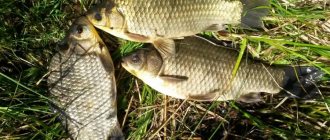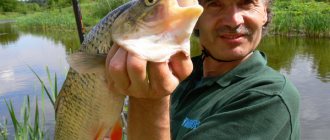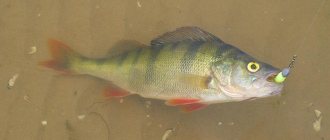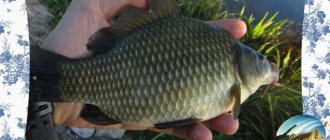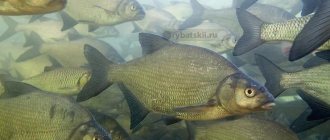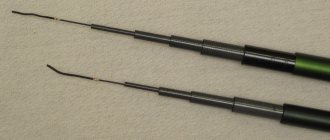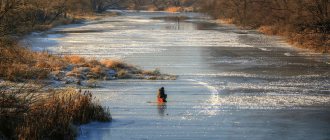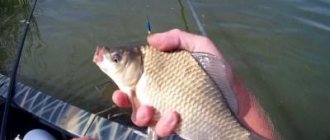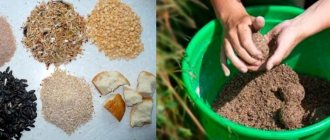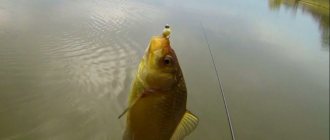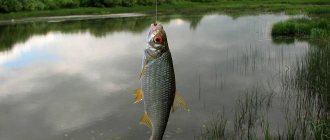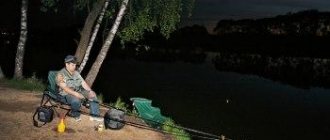Mountain fishing.
High water in the Amur and its tributaries, flooded banks. Impression, there are no fish here. It would seem that you can give up on fishing... I suggest you discover an alternative - fishing on mountain taiga rivers. If this is your first experience, then you will discover the wonderful world of the Far Eastern taiga, crystal clear waters and the rather peculiar inhabitants of these waters. October is perhaps the most suitable time for such fishing, since it is during this period that fishing becomes easier, more confident, and does not require much knowledge in this area.
It is in October that the so-called fish migration occurs. What does it mean? Fish do not winter in the upper reaches of rivers, since they often freeze and there is no constant influx of fresh, oxygen-bearing water. Grayling and lenok live in mountain rivers; unlike Amur fish, they cannot live in water with a low oxygen content. And they will not fall asleep, unlike, again, Amur fish. Accordingly, with the arrival of low temperatures (September - October), snow often already falls in the mountains, many places in the rivers are intercepted by ice, the water level drops, there is also little food, and the fish begin to roll into wintering pits (these are the deeper parts of the rivers, where freezing and often there are underground springs that bring oxygen; aquatic benthos remains here - nutrients).
What do we need? The minimum fisherman's kit for fishing on a mountain river includes the following components. Wading boots or a wading suit (overalls), made of rubberized fabric, or specially treated nylon, that is, from so-called non-breathable materials that do not allow water to pass through and allow you to move in the water. Since this type of fishing is called wading: you are at least ankle-deep in water, and at most waist-deep. Boots on the Khabarovsk market cost from 900 rubles, a wading suit from 2,500 rubles.
Disadvantages of such a suit.
- All the heat, all the moisture that your body releases when you move remains in your suit. Consequently, the clothes get a little wet from the inside, and therefore you may freeze.
- Weight of overalls.
- The sole of the boots of the overalls, although corrugated, is still quite slippery. It’s just designed to move through silt, mud, and you will move over stones with a coating of algae.
Waders
So be careful! There is an alternative. You can purchase a specialized wading suit, waders, which are made from two types of fabric - gore-tex (breathable) or neoprene (foam rubber sandwiched between two layers of fabric), similar materials are used in diving suits. There are two types of waders: those immediately equipped with boots, or those with wading boots included separately. These suits are specialized in mountain fishing - the soles of their shoes are made of artificial felt, which does not slip when walking, it does not rot and is not afraid of water. It’s much more comfortable to walk around while fishing in this outfit!
The price of waders with boots (made of neoprene) is from 3,500 rubles. Waders for boots (made of gore-tex material) - from 4,500 rubles. Boots with felt soles - from 3,000 rubles.
The next thing you will need is a fishing rod. The fishing rods used are quite specific. How are they different? Firstly, it's lightness. After all, the fishing rod is in your hand during the entire fishing period. Secondly, it is compact. If we are in open areas and don’t move around much, the compactness of the fishing rod is not so important for us. But there are times when we need to move along the river bank or along the river itself, often littered with fallen trees (the so-called windbreaks), and then compactness is extremely important.
Fishing rod
If your fishing rod is long, it will be very awkward for you to move around with it. Therefore, the recommended length (for example, for rivers like the Khor or Anyui) is from 3.5 to 5 meters. In addition, the fishing rod should be quite rigid in action (the fishing rod that you used to catch the same crucian carp will not work). I advise you to inquire further about the specifics and differences between these two types of fishing rods from the consultants of specialized stores.
The next point is kan (aka haryuzyatnitsa, box). This is a small container that you carry with you and put caught fish there. It is inconvenient to return to the shore all the time to leave the fish there, or it is inconvenient to carry a fish tank with you. This could be a wicker basket of a specific configuration, a plastic box, or, as a last resort, some use a cut-off rectangular plastic canister. When there is nothing else to replace it with, they even use plastic bags.
Equipment. Again, it's a little different. Floats are used with a medium load capacity (from 3 to 8 g), usually round or oval in shape, without long antennas, with one end weight, from which there is usually an attached leash with a hook. Ask consultants in city stores about equipment options (you need clarity here).
You can go mountain fishing and spinning. The only thing is that you don’t need to use a long one (the rivers are not that wide). The usual length of a spinning rod for mountain fishing is 2.1-2.4 m, according to the test - from 5 to 45 g, with a fast action. Among the baits are spinners (according to the accepted size of bluefox 3, 4 - if we are working on lenka and 5 - if we are working on taimen), wobblers (with medium and small depth, the shape of which is mainly “minou” and “gobies”). But, believe me, getting to know mountain fishing is more interesting with a fishing rod! This option is much more exciting and productive. Spinning still has specifics that you need to learn from more experienced fishermen, or gain your own experience. The fishing rod is much simpler in this regard.
Bait
Bait. Artificial baits are used. They are called differently: chemistry, flies, jigs, etc. This is an imitation of aquatic insects made using natural and synthetic materials. These baits have a wide variety of shapes and colors; in almost all specialized stores in the city they are presented in a fairly large assortment.
Since we will be fishing in the fall, flies of various orange (from dark terracotta to bright, chemical), green (from dim khaki to dark marsh) colors are suitable. I can advise. It makes no sense to take one fly. It is very difficult to guess which fly will work. Experienced fishermen go fishing with sets of up to a thousand pieces. It is clear that you will not immediately acquire such a collection. The minimum set you will need for the first time is 10-15 pieces. Prices: from 25 rubles for a factory-made bait, up to 140 rubles for a hand-knitted one by a famous craftsman. Today - just briefly about what is necessary. Well, in the next issue we will tell you about fishing techniques and fishing mountain rivers in our region.
Fishing for salmon with a spinning rod in the mountain rivers of the Far East
Date: October 1, 2015 | 128
I have very little experience in fishing on fast mountain rivers. It is limited both in time and in territory (by fast rivers and streams in the south of Primorsky Krai). However, I have already learned some points and want to share them in this article. My total fishing experience is quite large, so, based on it and on the basis of new observations, I allow myself to express a number of opinions on spinning fishing in fast mountain rivers . We will talk about gear, bait, promising places, optimal fishing conditions, and fishing strategy.
Mountain rivers are rivers flowing from mountains, high hills, hills, flowing in gullies, valleys between hills, rivers with a predominantly rocky bed, many rapids, rapids, and snags. The water in such rivers is usually cold and crystal clear. Just like the terrain over which these streams flow, the water regime of mountain rivers can also be called complex.
In winter, a rushing river may never freeze. Only areas with relatively calm currents, backwaters, and deep places are covered with ice. Of course, it all depends on the severity of the frost.
In the spring, after the snow melts, after heavy rains, even small rivers can turn into a menacing stormy stream. Floods on mountain rivers are very serious. The rise of water can be orders of magnitude higher than a normal drain. At this time, the river becomes muddy, carries heaps of garbage, and uproots trees in the floodplain. During the spring storm, fishing on mountain rivers is not possible.
Summer and autumn are the main periods when you can successfully fish on a mountain river. Of course, after prolonged rainfall in the upper reaches, floods or simply rising water may occur. But this is situational.
In fast mountain rivers, rivers, streams, various representatives of the salmon family (actually salmon, whitefish, grayling) are found and caught. Trout, lenok, grayling, taimen, etc. and so on.
These fish are caught with various amateur gear: spinning rods with artificial baits, fly fishing with artificial flies or live insects, float rods, nodding rods, etc.
I prefer to fish fast rivers with a spinning rod. Although, other indicated methods can be very effective.
The choice of spinning rod for a mountain river depends on two main factors: the weight of the bait and the size of the expected catch. So, if you are going to fish with small spoons, ultralight wobblers, and the catch is counting on fish weighing up to 1-1.5 kg (trout, medium-sized lenok, parrot, grayling), then choose the most elegant ultralight spinning rods with a top dough of no more than 8-10g (0 -3g, 0-5g, 1-7g, 2-10g). The action of the rod is usually medium or even slow in order to more effectively dampen the jerks of strong fish. And even a small representative of salmon, even when fished in an area with a strong current, is a serious test for elegant tackle.
If the weight of the baits increases, then, accordingly, they take rods with a higher test range, which, in fact, these baits are included in. If the hunt is for large inhabitants of a mountain river (taimen, chinook salmon, large lenok, etc.), then more powerful rods and other components of gear are used.
A light spinning reel uses a spinning reel of sizes 500, 1000, 1500. Very rarely 2000. When catching seasoned river predators, it can be 3000 or 5000, or even a powerful multiplier.
It is better to use fishing line rather than cord. The stretchability of the fishing line is an additional factor that allows you to dampen strong jerks of the fish. In the ultralight version, the line can be very thin 0.14-0.18mm. To hunt for large trophies, we take thicker, stronger fishing line.
If you are going to use rotating spoons as bait, then tie a swivel with an American clasp to the end of the fishing line. If you fish only with wobblers, then you can get by with one fastener.
I prefer to fish in fast rivers with spinners. It seems to me that these spoons are the most versatile. They can be used to fish in holes, rapids and other characteristic areas of the river. Wobblers, oscillating spoons and surface baits (ala, “mouse”) can only be used in certain conditions.
So, it is better to fish deep pits with calm water using suitable wobblers. Some local points are a small vibrator that plays beautifully when falling. And the spinner may give way in specific places, but it catches everywhere!
On mountain rivers, especially small ones, the use of high-quality spinners is very important. It is necessary for the spinner to start instantly, without spending even half a meter on acceleration. Indeed, in the cramped conditions of small mountain rivers, even a few centimeters of idling the spinner without rotating the petal is a lost opportunity for biting fish! Also, it is very important that the turntable plays stably in the streams of the river with a greatly varying flow speed. Murans, Mepps, Blue Fox perform well. But for now, in the ultralight segment, Maniacs are beyond competition. No other spinners get into action so quickly and pass through areas with difficult currents so consistently. In addition, pleasant bonuses are: the sharpest tee and the presence of a cool front sight on it. These little things are especially important when fishing on a mountain river.
In mountain river conditions, microoscillators perform well. I have previously written several reviews on baits of this class. You can familiarize yourself with them. Review 1, Review 2, Review 3.
If we talk about wobblers, then everything is very individual, based on the conditions of a particular place on the river. The most important and general condition for wobblers is stable play in fast currents. Sometimes it is worth using a small diver that can pass near the bottom of the hole, sometimes a sinking high-frequency wobbler to fish the reaches. Of course, wobblers from Japanese manufacturers perform well in mountain rivers: ZipBaits, Jackall, Smith, SGDesign, etc.
Now let's talk about places where the chances of meeting and catching fish on a mountain river are higher. It is important to be able to read the river and present your baits intelligently, and not just whip at random.
So, on any fast-moving river there are sections with a fast, stormy current, sections with a slow, calm current, or without it at all, and intermediate sections, the transition from a calm flow to a rapid one. It is the latter, areas with average flow speed, that should be perceived as the most effective. Those. if there is a riffle on the river, then you need to fish the area in front and behind it.
On a stormy riffle or rapids, the current is too powerful. Firstly, fish are extremely rare there. Only if behind large boulders. There, the fish have to fight against a strong current, it is difficult to notice the passing food due to the foaming water, and it is difficult to react and catch the tasty morsel rushing past with lightning speed. In quiet places, on the contrary, there is little food available and there are no normal shelters for fish. And in areas with moderate currents there is the right combination of all factors. And there is a lot of food passing through, and there are enough stones at the bottom as shelter, and you don’t have to fight the very powerful flow.
Pits are also very promising places on fast mountain rivers. It is in the pits that you can meet the largest inhabitants of the mountain river. The holes are formed due to the features of the topography, rocky outcrops, bends in the riverbed, fallen trees, individual snags or entire rubble.
There may be a very weak, barely noticeable current in the pit, or there may be a section with reverse flow and whirlpools. Well, and a depth that is many times greater than the depth in the surrounding, ordinary sections of the river.
Along with full-fledged holes, you should also pay attention to small pits and depressions, usually near snags, on steep banks, behind large stones.
In such places, the current is calmer, and there is somewhere for fish to hide, and some food can fall into the water from overhanging bushes or tree branches.
Very good places are the convergence of streams, river streams with different flow speeds. Where there is a fast, impetuous stream next to relatively clean water, there is usually fish.
An additional highlight of such a place may be the presence of driftwood and large stones at the bottom.
In general, fish in a mountain river do not really like to stay where the bottom consists of sand or small pebbles. And where there are large stones, boulders at the bottom, even protruding above the surface, the fish have a place to hide from the current and it stands there with pleasure.
Smooth stormy rifts, rapids...
... and areas with a quiet current and a flat pebble bottom are practically hopeless.
If we talk about the environment, time of day, lighting, then it’s good to fish on mountain rivers early in the morning, in the evening, and at night. During the day in cloudy weather. When the sun is bright and high, it is extremely difficult to get close to a wary, watchful fish unnoticed. And at this time it is better to do something else.
The fishing strategy on a mountain river is running fishing. You need to go upstream and fish promising areas, throwing the bait up or across the current. If we fish with a spinning rod, then it is important to choose a bait that plays well when moving with the current. As I mentioned above, turntables do this best. All that remains is to choose the size and type of spoon for a specific area and a specific flow speed.
Share with your friends:
Category: Catching predatory fish
Tags: Mountain river, Lenok, Salmon, Pestrushka, River, Spinning
Types of fish to catch
The Black Sea coast of Abkhazia abounds in various commercial fish, including:
- Black Sea horse mackerel.
- Sea bass (Smarida).
- Various mullet.
- Sultanka (red mullet).
- Bluefish.
- Pyramid.
- Seabass (Lavrak).
- Sea crucian carp (Laskir).
- Katran or Black Sea shark.
- Gorbyl.
- Karagöz.
- Needle or garfish.
- Salmon, also known as brown trout.
- Pelengas.
- Stingray (sea cat).
Fishing in Abkhazia
For fishing, most fishermen prefer Black Sea horse mackerel. Owners of boats located at the pier in Gagra or Sukhumi offer fishing with spinning rods and the so-called “tyrant” in the form of an elongated fishing line at the end with a weight and several tied leashes with hooks. They definitely have shiny foil attached to them. The catch is especially successful in the spring before the influx of tourists. The fish belongs to the predatory breed, living at depths of 30 m.
It should be borne in mind that at the height of the tourist season (from June to September) only small fish stay near the shore, but they can also bring a lot of pleasure from fishing. It is imperative to have accessories for removing the hook with you - sea predators swallow deeply, and the abundance of prickly (and sometimes poisonous) spines makes it quite difficult to work with the catch.
Tyrant on a spinning rod
Devices for summer and spring catch differ in the number of hooks. For summer there are no more than 10 of them per tackle, in spring - 20 or more. Using an echo sounder, a school is detected, followed by casting a spinning rod and retrieving the catch. Each cast is successful with a fish on each of the many hooks. The size of the fish is not large - up to 15 cm in length and weighing 100 g. The exciting process is always accompanied by a lot of unforgettable moments.
